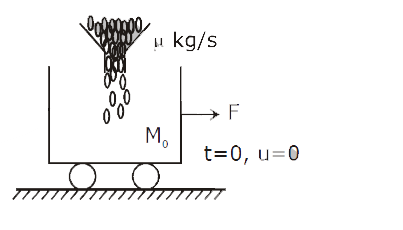An open water tight railway wagon of mass coats at an initial velocity without friction on a railway track. Rain drops fall vertically downwards into the wagon. The velocity of the wagon after it has collected of water will be :-Solution in Gujrati
The correct Answer is:C
Topper's Solved these Questions
- BOOK - ALLEN CHAPTER - CENTRE OF MASSEXERCISE - EXERCISE-III41videos
CENTRE OF MASS
- BOOK - ALLEN CHAPTER - CENTRE OF MASSEXERCISE - EXERCISE-IV A32videos
CENTRE OF MASS
- BOOK - ALLEN CHAPTER - CENTRE OF MASSEXERCISE - EXERCISE-I40videos
CENTRE OF MASS
- BOOK - ALLEN CHAPTER - BASIC MATHEMATICS USED IN PHYSICS &VECTORS EXERCISE - EXERCISE-IV ASSERTION & REASON11videos
BASIC MATHEMATICS USED IN PHYSICS &VECTORS
- BOOK - ALLEN CHAPTER - ELASTICITY, SURFACE TENSION AND FLUID MECHANICSEXERCISE - Exercise 5 B (Integer Type Questions)3videos
ELASTICITY, SURFACE TENSION AND FLUID MECHANICS
Similar Questions
A particle of mass m, kinetic energy K and momentum p collision head on elastically with another particle of mass 2m at rest. After collision. :
Column IColumn II(A)Momentum of first particle(p)3/4p(B)Momentum of second particle(q)−K/9(C)Kinetic energy of first particle(r)−p/3(D)Kinetic energy of second particle(s)8K9None02:17View SolutionFig. shown a uniform square plate from identical squares at the corners can be removed. (a) Where is the centre of mass of the plate originally ? (b) Where is it after square 1 is removed ?
(c ) where is it after squares 1 and 2 are removed ? (d) Where is c.m after squares 1,2,3, are removed ?
(f) Where is c.m after all the four squares are removed ? Answer in terms of quadrants and axes.
 01:49View Solution
01:49View SolutionThe centre of mass of a non uniform rod of length L whoose mass per unit length varies as p=kx2/L, (where k is a constant and x is the distance measured form one end) is at the following distances from the same end
05:15View SolutionAssertion: If the initial and final positions coincide, the displacement is a null vector.
Reason: A physical quantity can not be called a vector, if its magnitude is zero.04:01View SolutionTwo soap bubbles A and B are kept in a closed chamber where the air is maintained at pressure 8N/m2.The radii of bubbles A and B are 2cm and 4cm, respectively. Surface tension of the soap-water used to make bubbles is 0.04N/m. Find tha ratio nB/nA, where nA and nB are the number of moles of air in bubbles A and B, respectively. [Neglect the effect of gravity.]
01:35View SolutionA wagon of 200 kg is moving on a smooth track with velocity of 2 m//sec . A man of 80 kg also runs in the wagon with a velocity such that speed of the centre of mass of the system is zero. Find the velocity of man relative to the wagon (in m//s).
02:56View SolutionCalculate the uncertinty in the velocity fo a wagon of mass 200kg whose position is known to an accuracy of ±10m.
04:42View SolutionAn open water tight railway wagon of mass 5×10(3)kg coats at an initial velocity 1.2m/s without friction on a railway track. Rain drops fall vertically downwards into the wagon. The velocity of the wagon after it has collected103kg of water will be :-
03:07View SolutionAn open water tight railway wagon of mass 5×103 kg coasts at initial velocity of 1.2m/s without friction on a railway track. Rain falls vertically downwards into the wagon. What change then occurred in the kinetic energy of the wagon, when it has collected 103 kg of water
03:41View SolutionA railway wagon of mass 100 kg is pulled with a force of 1000 N. What is its acceleration?
04:42View Solution80 railway wagons all of same mass 5xx10^(3) kg are pulled by an engine with a force of 4xx10^(5) N. The tension in the coupling between 30 th and st 31st wagon from the engine is :-
03:40View SolutionA 1000 kg engine pulls a train of 4 wagons each of 2500 kg along a horizontal railway track . If the engine exerts a force of 50000 N on wagons and track offers force of friction 10000 N, then calculate
(i) The net accelerating force
(ii) The acceleration of the train
(iii) The force of wagon -1 on wagon - 2View SolutionFour identical railway wagons each of m, are coupled together and rest on a smooth horizontal track. A fifth wagon of mass 2m and movingk at 5m/s collides and couple with the statioinary wagons. What is the speed of the wagons after the impact?
02:07View SolutionFind velocity of wagon as function of time when it is being filled with stationary hopper at the rate μ kg/sec. and constant force F is applied horizontally on the wagon as shown in figure.
M0 is the mass of the wagon and initial speed of the wagon u = 0 at time t = 0.
 05:15View Solution
05:15View SolutionA 1000 kg engine pulls a train of 4 wagons each of 2500 kg along a horizontal railway track . If the engine exerts a force of 50000 N on wagons and track offers force of friction 10000 N, then calculate
(i) The net accelerating force
(ii) The acceleration of the train
(iii) The force of wagon -1 on wagon - 207:11View SolutionA wagon is moving along a straight railway track with a velocity of 3.2 m⋅s−1. The wagon is being loaded with coal in moving condition at a rate of 540 kg.−1min. How much force is to be applied to move the wagon at a constant velocity?Assume, the initial velocity of the coal at horizontal direction is zero.
02:52View Solution

